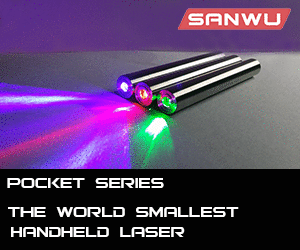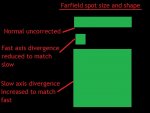I have heard people say that a FAC actually expands the slow axis but this never made sense to me for anything but possibly CNC use but not for producing a low divergence beam.
If the typical plano aspheric FAC acts upon the fast axis as the beam coming out of the P/N junction reaches square there by reducing the fast axis divergence and producing a square beam that continues to diverge evenly ( remaining square ) it will be diverging evenly on each axis at the original rate of the slow axis, this when collimated through say a 2E lens will produce a square spot without the long side, but rather 2 short sides, a much smaller far field spot............however if the FAC acts upon the slow axis some place after the natural square was reached and expands the slow axis then we will have a square with 2 long sides, basically the long line/bar we typically see squared.
Sure we could use wider longer FL lenses and beam expanders, but we can do that anyway, if the FAC is not correcting the fast axis by reducing it's divergence but rather expanding the slow axis divergence only in order to square the beam then we still have a very highly divergent beam only worse I would say.
NOW for say a home CNC where a wider lens ( example 30mm ) is not an issue as it could be for pocket carry, a square beam is preferable for uniform cutting in all directions, but for producing a tight stargazing beam with these MM diodes that have one very rapidly diverging axis we would want to reduce the fast axis to match the slow axis.
This is using a single plano aspheric FAC but with the fiber FAC Chris linked the article about we see it acts upon both the fast and slow axis so our far field spot after a typical coli lens could be improved, squared and while some amount longer than the normal bar's short side also shorter than the normal bars long side, this is what the advertisement could have meant by ( FAC fiber ) which is interesting and promising, fingers crossed as we wait to see.










